Making The Right Choice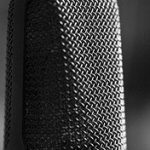
There are so many different microphones being made today that it can be very confusing when the time comes to buy one. Let’s take a look at the common elements of professional studio recording microphones to help us make the right choice.
Understanding how they work is probably a good place to start in deciding why we might choose one kind over another.
The Basics
A microphone is a device that turns one form of energy into another form of energy, technically known as a transducer. In this case, it turns sound waves into electrical energy. It acts much the same way that our ears do when sound waves enter them, the inner ear turns the sound waves into electrical energy and our brain interprets it as hearing.
If you think about how the speakers for your stereo work, they change electrical energy into sound waves by making the speakers move and push air so that our ears can hear what the translation means.
A microphone works in the exact opposite way that a speaker does.
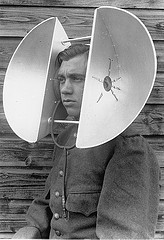
From The Diaphragm
You have probably heard that term, right?
If you are in voice work or you are a singer, you are more than likely familiar with someone asking you to speak or sing “from the diaphragm.” We all have a diaphragm, which is a large muscle that helps us move air in and out of our lungs.
Well, did you know that every microphone has a diaphragm, too? And that diaphragm is the key element in converting the energy from sound waves into electrical signals.
No microphone would work without it.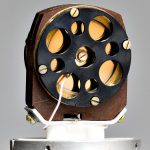
They can be made of paper, plastic or even aluminum, but they all do the same thing. As sound waves reach the diaphragm it will vibrate, just the same way a speaker cone will vibrate or the same way your ear drum will vibrate, and that, is in turn, converted into electrical signals.
But not all microphones are made the same way, in fact, there are very specific characteristic design elements that allow them to excel in different applications.
Dynamic Microphones
These mics use a moving coil and magnet behind the diaphragm to capture sound and it can take a lot of level to get the coil moving.
That means that they can handle higher sound pressure levels like guitar and bass amps, screaming vocals, drum kits, and…
hard sell voice overs.
Dynamic mics are used mostly for live performance situations because of their excellent ability to prevent feedback but don’t discount them for voice over recording. They will handle much louder signal without clipping than a condenser mic and are generally much more rugged as well.
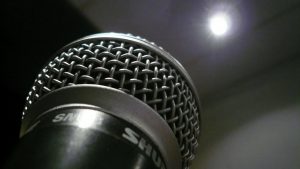
In fact, I used to engineer at a church for their Sunday masses and when the weather allowed and on special holidays the service would be outdoors.
Every week I would set out and assemble all the equipment and when the service was over, tear it all down and store it for the following week.
One time I accidentally left two extra gooseneck dynamic mics, that we would use for the podium, next to the drum set on the stage.
A little way through, someone asked a guest drummer to play one of the songs and in his excitement and rush to get behind the kit, he picked up the two microphones and immediately started playing the drums with them. (That was when I had my first fake heart attack)
After it was all over, I was eager to check the damage. Except for the little foam filters that we were unable to find anywhere, both microphones still worked perfectly!
That would not be possible with the next microphone.
Condenser Microphones
Condenser mics are used more in studio work and especially in voice work because they can pickup much more detail and they have a greater output level than dynamic mics. The reason for that is they are electrically charged by an added voltage commonly known as phantom power.
It’s kind of like power steering in your car.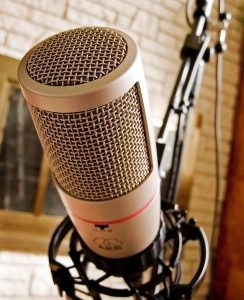
There are actually two plates in these microphones with one of them being very thin and acting as the diaphragm. The phantom power provides a voltage between the plates so that the electrical charge increases and decreases with the movement of the diaphragm.
This results in the diaphragm being more sensitive and makes it more responsive than those of dynamics, so you get more high-end detail and breathiness. But for hard sell voice over it may bring out more detail than you might want if you are pushing your voice, push a little more and it can easily overload.
They are also affected by humidity and temperature, which is something you won’t have to worry about with a dynamic microphone.
Ribbon Microphones
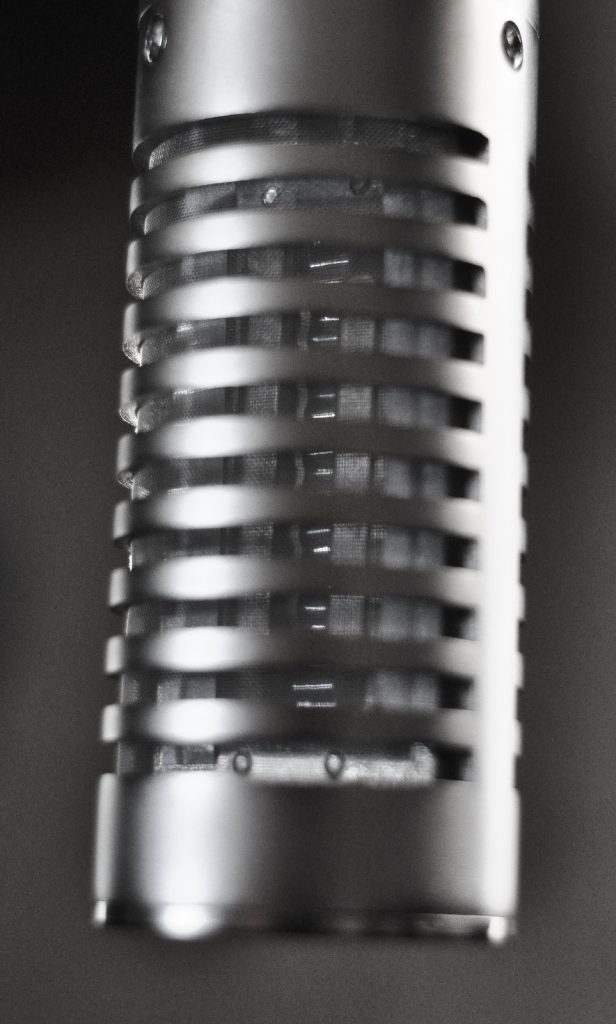
Another type that uses a delicate ribbon of foil for the diaphragm is the ribbon microphone. The ribbon is gently creased to make is springy so it will move easily as well as provide more surface area.
It looks much like what is in the middle of corrugated cardboard. These are extremely delicate and sensitive microphones but they have an excellent high-frequency response that rivals that of most condenser mics.
They will mostly be used for instruments that have high frequencies like horns or for room mics or overhead mics for drums to capture the crispness of cymbals, but they can also be used for voice work with great caution, although it is not recommended.
That would be an expensive microphone to be experimenting with if you don’t know what you are doing, one “popping p” and you can easily destroy the ribbon. Never apply phantom power to ribbon microphones either, that’s a guarantee that you have just made a crucial and very expensive mistake that you will not be able to correct.
There You Have It…
The three categories that every microphone falls into according to the way they are designed to handle sound waves coming from whatever source they are put in front of to capture.
This should make it at least a little bit easier to decide which kind of microphone to use for your particular recording application, but there are still a lot of choices to make when it comes to brand and model, which will very likely depend on your budget.
As mentioned above, it might be worth having more than one microphone for variety as well as for application in terms of choosing a dynamic over a condenser for hard sell voice work.
Once you purchase your new microphone you may or may not have to choose a polar pattern.
As always you can leave a comment below. Tell me which kind of microphone you are using and why you made that chose.

Hi Jim,
I’ve been podcasting for a year. I have a Heil PR40 on a desk stand with a foam pop filter. I have an Avid MBox, a Behringer UB1204 mixer and a Dell Optiplex 960 computer DAW Adobe Audition. I do interviews using Skype.
I found VO and I love it!! am trying to absorb everything I can about it. Unfortunately, the Heil is not recommended for VO and I have limited funds for a really good mic. After a few weeks of research, I ordered a Audio Technica 2020 XLR condenser mic. I plan to upgrade in the future, but I need to use what I have now. I am waiting to see if it makes a difference. While I am waiting is there anything I can do to make my Heil work for VO?
I will tell you what I’ve done. I record in an open concept area (no doors). I have a quilt and bedding topper over the sliding glass doors behind me. The rest of the room has bookshelves to the right and left at various levels and carpeted floors. I put 2 pillows in a V behind the mic and I put a wool blanket over me and the mic.
I read your post on mic technique, but the support at Heil told me to place the mic 2-3 inches from my mouth. I would appreciate your advice. Thank you in advance
Hi Paula,
It sounds like you have done quite a bit to isolate your voice, and the Heil PR40 is not a cheap mic. It should be good enough for voice-over. But I would not use the foam pop filter. Instead, get a screen type pop filter that you can place AWAY from the mic at least 5 inches.
You should not be as close to the mic as the manufacturer recommends. That is going to produce too much proximity effect and that foam pop filter is not going to be effective enough to control the plosives that will occur, it will only suck up high-frequency range, which will give you a dull voice-over.
With all you have done to isolate sound, you should not be hearing much of your room at all, so now you just need to get at the right distance from the mic for a natural sound.
Maybe you could email me a sample of your audio and I could get a better idea how you can improve it.
Hi Jim. Great article.
So if I want a good mic to record my voice in studio my best choice would be a condenser mic. Do you know a brand in particular that is not too expensive but still of good quality that you would recommend me to buy? And does this kind of mic good to put in front of an amplifier or acoustic guitar to recorder in studio or should I choose another kind?
Thank you in advance,
Guy
Hey Guy,
Well…that really depends on your budget.There are some good and cheap mics out these days and you can actually get a large diaphragm condenser mic for around $30.00.
But if you are looking for a great mic for under $200.00 I use a Studio Projects B3 Condenser Microphone, Multipattern Studio Projects B3. Great sound and 3 polar patterns to choose from.
Studio Projects B3. Great sound and 3 polar patterns to choose from.
Above the $200.00 range and pretty much anything is going to work well for voice work. The further you go up in price the better quality you can expect and they may also give you more flexibility as far as polar patterns and the kinds of instruments they will work well with.
I also use two Neumann microphones that run about $3000.00 a piece. TML 170
TML 170
Neumann TLM 170 R mt | Multi Pattern Large Diaphragm Condenser Microphone Matte Black
and a Neumann U 89 i Studio Microphone Black Color U89
U89
AKG Pro Audio C414 XLS Instrument Condenser Microphone, Multipattern “>AKG 414 is a great all around mic for nearly any application.
“>AKG 414 is a great all around mic for nearly any application.
Thanks!
Wow $3000 for a mic. That’s something. I was more thinking like the other one you mentioned, the Studio Projects B3 at $159, it’s more in my budget. Thanks
The Studio Projects B3 is and excellent mic and I choose it very often over the more expensive ones. They also make a few other models that might work just as well for you.
Hi Jim,
This is a wonderfully educational and informative article!
I hope one day to begin making videos for my website and I will be returning to study your information before I decide on any equipment! 🙂
Christa 🙂
One of the biggest issues for many people with videos is the sound quality. Before you make any videos for your website or You Tube, read my post on how to improve video sound quality, it will make a huge difference in the experience of the viewer.
http://voiceathome.com/how-to-improve-video-sound-quality
Some very good information. Anyone in internet marketing that is considering video’s should read this as there is some great information here.
Thank you Brian,
I think the biggest improvement that can be made right now in the tutorial video field is in sound quality.
My son is totally obsessed with recording himself. This is a very good article on microphones and details everything. I am going to show him this and hopefully it will be useful to him 🙂
That is great Andy, thanks! How is he recording himself now and what is it that he is recording? Maybe he will have some questions for me that I can help him with.
Very Awesome.
Reminds me of the 1960’s when I was in my childhood years.
Oh how I wished I could have Snatched up one of those microphones I saw in my church at the time.
You much as breathed lightly, the things would picke you up 3 feet away.
Clear too!!!
Yeah Bob, it is amazing how well some microphones “hear” what is around them. Wait a minute, did you say you wanted to snatch a microphone from a church!?
When I was a kid I went to a country auction with my parents and my mom bought an unknown contents box just for fun. Among other things, there was an old mic from the 1940’s in the box but there was no longer any cord attached. So I threw it away. With my knowledge now I could have fixed that mic easily and I would have a great vintage microphone on my hands today.
Jim, interesting article on microphones. I never knew the difference before and what each type is used for.
With your story about the drummer using microphones as a drumstick ouch!
I kept picturing in my mind Roger Daltry swinging his microphone around in the air.
I am guessing that was a dynamic microphone?
Yes, Roger Daltry was certainly using a dynamic microphone. With a voice that powerful, I might be afraid to put a condenser mic in front of him!
Dynamic mics can really take a beating because they don’t have any delicate components in them, they are all mechanical. If this page sparked your interest, check out my page on polar patterns.